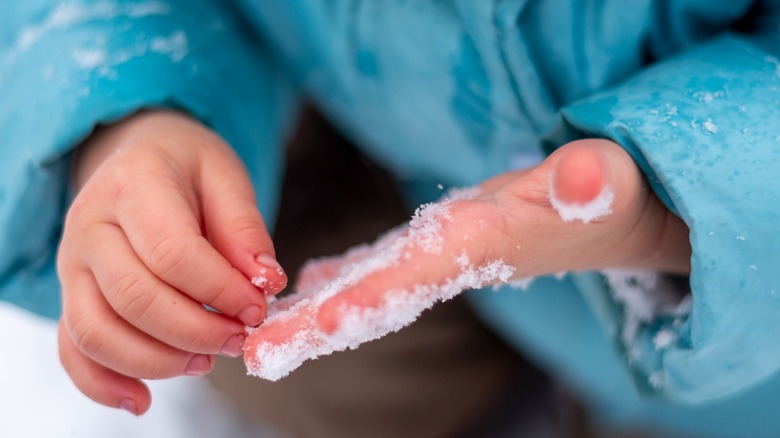How To Treat Frostbite At Home
When you think of the risk of frostbite, you might associate it with high-altitude alpine ascents or even a trip to the arctic, but frostbite does not only occur in the mountains or the polar caps. According to the National Health Service, frostbite is a type of damage to the body that happens when not properly clothed in temperatures below 31 degrees Fahrenheit. As your blood vessels get smaller from the cold exposure, blood flow to the extremities decreases, which can contribute to the affected body tissues freezing. The resulting freezing can cause damage and even kill the tissues.
Cold exposure can cause damage to areas of your body, like your ears, feet, fingers, lips, hands, nose, and toes (per WebMD). There are several stages of frostbite, ranging from early to advanced. In the early stage of frostbite, the skin can turn pale or yellow and feel like it burns or is prickly. During the intermediate stage, the skin becomes hard or could blister. The advanced stages of frostbite can result in the skin becoming cold, hard, and turning a darkish color, like blue or black. Notably, if you cannot feel your skin for a period of time, experience severe pain as you warm up, feel your skin is hard or alters color, or has blisters, you should seek emergency medical attention. However, in minor cases, frostbite can be treated at home. Here's everything you need to know about how to treat frostbite at home.
Tips for treating frostbite at home
Treating frostbite at home starts with a few simple steps. First, try to cover the affected areas with clothing, according to WebMD. If you think you have frostbite, you should refrain from touching the affected skin or body areas and getting out of the cold and into a warmer area, like indoors. It is also important to remove any wet materials of clothing you have and get dry and warm. Keep in mind, it's crucial to avoid placing your affected areas of skin in hot water as it can cause more harm to your body. However, soak the affected areas in warm water, which is about 107 degrees Fahrenheit or set a cloth soaked in warm water over the affected area for a minimum of 30 minutes.
In addition, be sure to take a few precautionary measures to help prevent frostbite. The experts at National Health Service recommend that you wear warm, weather-appropriate clothing that covers the areas at risk for frostbite. You can wear a winter hat for your ears and head, a scarf to cover your mouth and nose, mittens for your hand and fingers, and boots for your feet and toes. It is also important to avoid drinking alcohol or smoking when in the cold, as alcohol can make you colder and smoking can make your blood vessels smaller.


